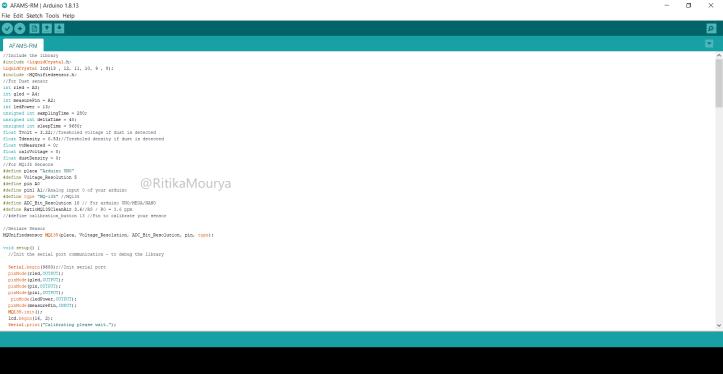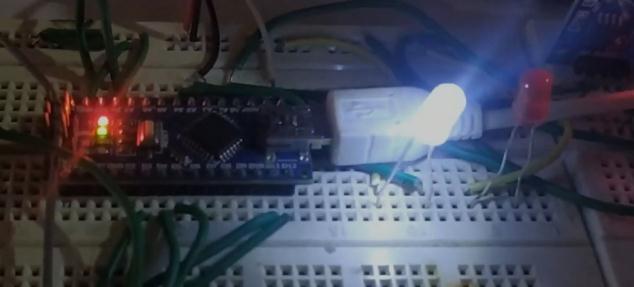International Research Journal of Engineering and Technology (IRJET)

Volume: 09 Issue: 04 | Apr 2022 www.irjet.net
e ISSN: 2395 0056
p ISSN: 2395 0072

International Research Journal of Engineering and Technology (IRJET)

Volume: 09 Issue: 04 | Apr 2022 www.irjet.net
e ISSN: 2395 0056
p ISSN: 2395 0072
1BE Student , Dept. of Electronics Engineering, Shri Ramdeobaba Collage Of Engineering And Management, Nagpur, Maharashtra, India
2Professor, Dept. of Electronics Engineering, Shri Ramdeobaba Collage Of Engineering And Management, Nagpur, Maharashtra, India ***
Abstract In India, burning incense is a part of worship. Due to the rise of diseases and bacteria related to mosquitoes, people are turning to the use of mosquito coils as they are cheap and provide protection. However, there has been evidence of harmful gases produced by the burning of these products. Not only are these products harmful to the lungs, they can also cause cancer. The gases produced by burning incense and mosquito coils are known to release harmful chemicals into the air. If these are not taken out, people will suffer from various health conditions such as asthma. Unfortunately, there is currently no reliable scientific evidence regarding the long term effects of airborne pollutants. This makes it important that people take measures to prevent their exposure to these harmful chemicals. One of the main factors that contributes to the development of airborne pollutants is dust . A filtration system can prevent dust accumulation on surfaces, trap airborne mold spores, bacteria, viruses, and even bad odors. That's why we wanted to develop a system that can remove these gases like CO, NO2, and SO2 and produce fresh, harmless air even after burning incense and mosquito coils.
Key Words: Airborne pollutants, Incense stick, Mosquito coils, Filtration system, Monitoring System, Health conditions, Diseases .
In general, people believe that outdoor air pollution is harmful and that they are safe at home. Yet, the reality is quite different. The indoor air quality can be 10 15 times more polluted than what people breathe outside. The air in the house is polluted by various airborne pollutants, dust, and bacteria and germs that cause disease. In countries like India, where religion is given a lot of importance, incense sticks are burned as part of worshiping. Sulphur dioxide (SO2) and carbon monoxide (CO)gaseshavebeenfoundinburningincensestick.Gases such as CO, CO2, NO2, SO2, and others are produced by incense burning. CO, CO2, NO2, and SO2 are extremely harmful for us. If not removed, these gasses will cause various life threatening illnesses in the house or workplace, such as Asthma and Bronchitis. In this project we have developed a low cost air filtration system. The systemwillfocusonreductionofCarbonDioxideusingUV laser.CarbonDioxide isone ofthegreenhousegasand is one of the major cause of asthamatic and respiratory
problems/diseases. Carbon dioxide when passed through the rays of UV light breaks into Carbon [C] and Oxygen [O2],therebyreducingthegreenhouseCarbonDioxidegas andincreasingOxygencontentinair.Testingisdoneona burning incense stick which also releases a lot of smoke apartfromCO2
Toremovepollutantsfromtheairofanofficeorhome,air purification systems are used. Here are a few of the methods to accomplish this : HEPA Filter, Carbon Filter, UV cLight.
One of the most common methods is HEPA filtration. Air filters with a diameter of 0.3 microns can theoretically capture 99.97% of dust, pollen, mold, bacteria, and other airborne pollutants. The diameter specification of Dust particles, pollen, mold, bacteria, as well as other airborne particles larger than 0.3 microns (m) should all be removed by this design. The diameter specification of 0.3 microns represents the worst case, the most penetrating particlesize(MPPS).
Carbon filtration, or active carbon filtration, is a widely used processthat works by adsorbing pollutants ontothe surface of a filter. Water or air can be effectively purified by this method if certain organic contaminants (such as unwanted tastes or odours or micropollutants) are present,suchaschlorine,fluorineorradon.
The ultraviolet germicidal irradiation (UVGI) method is a disinfectionmethodthatusesultraviolet(orUV C)lightto destroy nucleic acids and disrupt DNA in order to eliminate or inactivate microorganisms. Ultimately, these microorganismsarerenderedinertandunabletofunction properly.
International Research Journal of Engineering and Technology (IRJET)

Volume: 09 Issue: 04 | Apr 2022 www.irjet.net

e ISSN: 2395 0056
p ISSN: 2395 0072
For Filtration process, we are using a pre filter, a carbon filter, HEPA filter , and UV light . We are using the "Pre filter"toperformapre filtrationprocessatprimarylevel. As we are using HEPA filter which perform the majoriety offiltrationprocesssoitsnecessarytoprotectittooasita bit costly too , so for that we are using "Carbon Filter" outside HEPA filter . At last we are using UV light to perform Disinfection , Sensitisation & kills micro bacteria too.


This project is divided into two parts one is monitoring systemandsecondthefiltrationsystem.
1. MonitoringSystem.
2. FiltrationSystem.
I. Monitoring System :
Inmonitoringsystemwearehavingourcircuitrypart.In which we have used arduino nano , LCD , sensors. In this circuitrywehaveusedtwosensorsoneisDustsensorand another is MQ135 which is nothing but our air quality sensor. Dust sensor will sense the dust particals and give ustheindicationwiththehelpofLED’s.Herewehaveuse four LED’s of different colour for better understanding . Now for MQ135 it will detect the air quality and give us the indication through LCD by displaying “NORMAL” ”ALERT!!”message.
Fig 2 :BlockDiagram.
Asyoucansee,herewehaveanexhaustfanandUVlight, which we have been implementing in our circuitry part too.
Fig -3:PrototypeofFiltrationSystem.

International
Volume: 09 Issue: 04
Journal of Engineering
Apr



This is our overall implementation , Here we are using 16x2 LED (for displaying the sensor outputs) We have 2 sensors,oneattheinputside&otheratoutputside.And we had use Aurdino NANO .We had a Dust Sensor to detect the unwanted dust particles from the air . Here we arehaving2LED's,White&Red.IftheAiriscleanitwill turnonwhiteoneotherwiseRed.
Now,asinourprototype,wehavebeenusinganexhaust fansowehaveresembleithereincircuitryasthemini fan as you can see in Fig 5,6, and we have use a Driver so it willnotputloadonAurdino.NowfortheUVlightwehave resembleitwiththelightstick.Thecomponentswhichwe have been using for Testing are instant stick ( its output gases mainly include Co and CO2 ) sanitizer for testing our air quality sensor leftover dust of instant stick for testing Dust sensor . So this is our setup without uploadingthecoding

Technology (IRJET)

e ISSN: 2395 0056
p ISSN: 2395 0072
04


Firstlywewillturnonthepower.Thenwewilldumpour codeinthearduino.Afterdumpingourcodearduinowill start running . So our LCD is turned on and the resemblanceofourexhaustfan&UVlightalsogetsturned on. ThatweanseethatinFig 7




Now we will see the working of our Dust sensor , here it will turn on white LED because it has not detected any dustinthesurroundingasyoucanseehere,whichmeans theairisdustfreecanseeitinFig 9

And now we will start sprinkling the instance stick dust overtheDustsensoranditdetectdustinsurroundingsoit willturnsRedrefFig10,11
AswehaveusedLCDtodisplayinput&outputreadingof thecomponentdetectedsoletsseehowitworks.Nowwe will check our sensors using incense stick because it contain co2 components in it .Now let the input sensor detectitand itturnsgreenwhichmeansthesensordetect the gases see Fig 12 and now it will show the reading in the LCD here .You can see the variation in the input & outputreading.Fig 13

International Research Journal of Engineering and Technology (IRJET)

Volume: 09 Issue: 04 | Apr 2022
e ISSN: 2395 0056
p ISSN: 2395 0072
Following are the costing of component used in both MonitoringaswellasFiltrationSystem:
1. MQ135SENSOR 2pieces 190Each 380Rs
DUSTSENSOR 1piece 520Rs
ARDUINONANO 1piece 350Rs
16x2LCD 1piece 150Rs
RELAY 1piece 90Rs
Observationtableconsistof:
1) Gases that were detected during testing CO , Alcohol andCO2inbothinputandoutputsensor.

2) Dustpresenceinsurrounding.
3) DustDensity.
Table 1: Observationtable
This readings were generated by burning the incense sticks. And this reading are taken by Arduino IDE serial monitor.
BATTERY+CAP 1piece 40Rs
POT 1piece 30Rs
LED'sRed,White 10Rs
SOLDERINGWIRE 2pieces 21Each 42Rs
CONNECTINGWIRE 14Rs
CONNECTINGPINS 30Pins 30Rs
RESISTOR 5Rs
DOUBLESIDEDTAPE 30Rs
PhilipsHEPAFilter 497Rs
UVlamp. 275Rs
SteelMesh. 80Rs
UVchoke. 100Rs
Polycarbonate. 136Rs
PVCpipe. 120Rs
PVCcap. 50Rs
FiberSheet 199Rs
Carbon 550Rs
Feviquick. 50Rs
Cutter. 40Rs
Wire. 10Rs
NutBolt+M seal. 30Rs
Thermacol. 50Rs
Exhaust 290Rs
project
International Research Journal of Engineering and Technology (IRJET)

Volume: 09 Issue: 04 | Apr 2022 www.irjet.net
Time has indeed come when we take up on ourselves the pleasant feeling of acknowledging the guidance and support offered to us by individuals who helped us in materializing this seemingly unending task. The most important acknowledgment of gratitude i wish to express is to my mentor and guide, Prof. Vishal Rathee, Department of Electronics Engineering, Shri Ramdeobaba College of Engineering and Management, who has put his valuable wisdom at our disposal. It has been a greatly enriching experience for me to work under his caring guidance.
[1]A Development of an Indoor Air Purification System withanIntegratedFiltrationStagesforReducingUltrafine ParticleConcentration IEEE.
[2]ArticleDESIGNANDFABRICATIONOFAIRPURIFIER.
[3]Dinesh Panicker paper on the topic Smart Air Purifier withAirQualityMonitoringSystem ResearchGate
[4]Air Pollution Monitoring System using IoT Iqra Javid, Sushant Bakshi, Aparna Mishra, Rashmi Priyadarshini IJEAT.
[5]Design of a Low Cost Air Quality Monitoring System UsingArduinoandThingSpeak
RitikaMourya. Bachelor’sOfEngineering. Dept.ofElectroicsEngineering RCORM,Nagpur,Maharashtra


VishalRathee AssistantProfessor Dept.ofElectroicsEngineering RCOEM,Nagpur,Maharashtra
Impact
e ISSN: 2395 0056
p ISSN: 2395 0072
value: 7.529